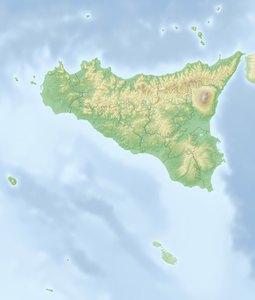Marettimo
| Marettimo | ||
|---|---|---|
| The port of Marettimo | ||
| Waters | Mediterranean Sea | |
| Archipelago | Egadi Islands | |
| Geographical location | 37 ° 58 ' N , 12 ° 3' E | |
|
|
||
| Highest elevation |
Monte Falcone 686 m asl |
|
| Residents | 684 (2011) | |
| Map of the Egadi Islands | ||
Marettimo is one of the Egadi Islands in the Mediterranean off the west coast of Sicily . Politically, it forms a district ( fraction ) of the municipality of Favignana of the Free Municipal Consortium Trapani .
Marettimo is the second largest of the Egadi Islands. Its highest point is the Monte Falcone with a height of 686 m slm Marettimo has 684 inhabitants (as of 2011 census). They live from fishing, from traditional handicrafts and increasingly from tourism.
History of Marettimo
Antiquity
Remains of human settlement can already be found on Marettimo from Greco-Roman antiquity. However, not much is known about the early antique history of Marettimo. The old Greek name of the island was "Hiera" and the Homer translator Samuel Butler suspects Marettimo to be the home island of Odysseus , whose wanderings are described in the famous Odyssey . Butler's thesis, like Odysseus' origin in general, remains highly controversial. On the other hand, archaeological finds have proven unequivocally a Roman settlement. Marettimo served the Roman Navy as an upstream observation point off the coast of Sicily. Because of its strategically important location between North Africa and the Italian mainland, Marettimo played a not insignificant role as an observation point in the Punic wars between the Romans and the Phoenician metropolis Carthage . Even today, the Roman fortification "Casa Romana", which can be visited freely, provides a testimony to these ancient times high above Marettimo's coast.
middle Ages
Since the fall of the Western Roman Empire , the fate of Marettimo has remained closely linked to the turbulent history of Sicily. At the end of late antiquity around 500 AD, the Vandals conquered Sicily and the Egadi islands of Marettimo, Favignana and Levanzo , together with and the formerly Roman provinces in North Africa. The rule of the Visigoths was in turn ended by the Arab Saracens . With the rule of the Normans over Sicily, who seized the island in the 11th century, the phase of Christian rulers over Marettimo begins. A relic of military history also provides evidence from this period. The Norman fortress “Punta Troia” can be visited on the side of the island facing Sicily.
Early modern times and modern times
After a phase of constantly changing rulers in the game of the great European powers, Marettimo was integrated into the Italian kingdom in 1861 as part of the “liberation” of Sicily under Giuseppe Garibaldis , the hero of the Italian unification movement. When Sicily became an autonomous region within the Republic of Italy in 1946 , Marettimo also received extensive self-government rights of Sicily in the Italian nation-state. After the Second World War , in which Marettimo, unlike the other Egadi Islands, was spared Allied bombings, many residents left Marettimo in search of more profitable, economic opportunities in Sicily or the mainland. Until then, most of the inhabitants of Marettimo lived almost exclusively from fishing, in addition to traditional handicrafts. Only recently has the trend towards emigration been curbed, primarily thanks to the island's tourist development.
Web links
Individual evidence
- ↑ http://dawinci.istat.it. Retrieved April 27, 2013 .
- ↑ The true home of Odysseus. Archived from the original on July 12, 2013 ; Retrieved April 27, 2013 .




